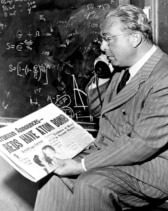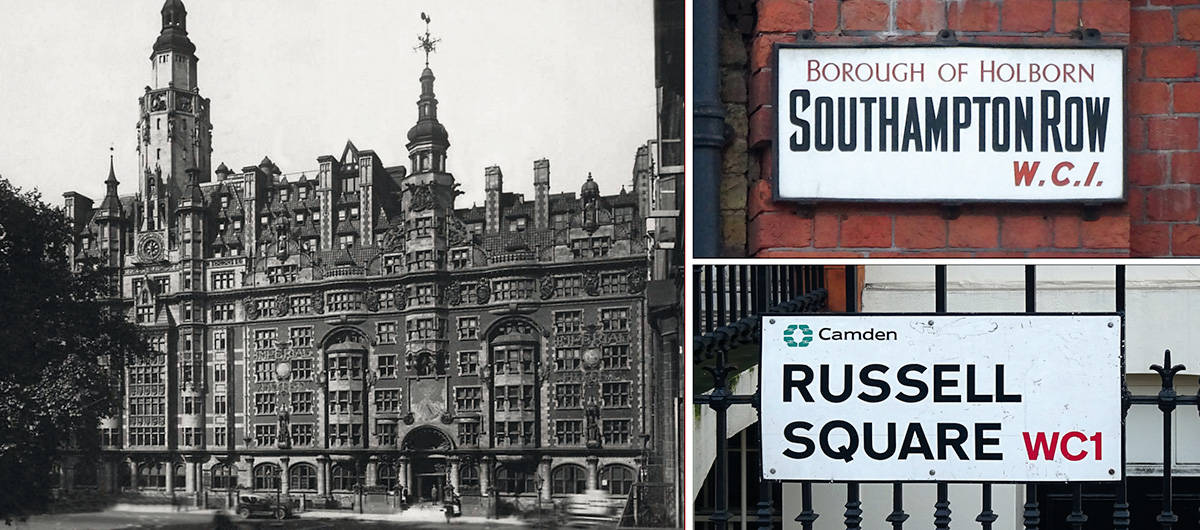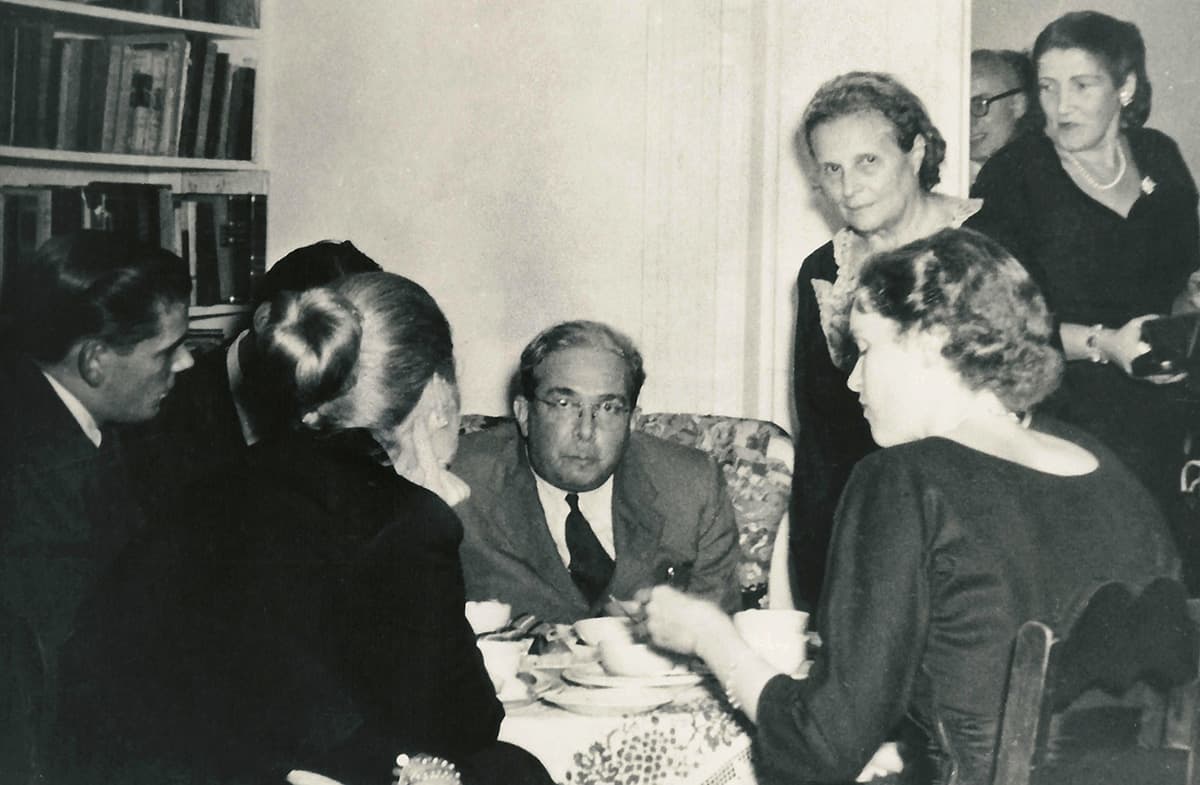Born 125 years ago, the Hungarian-born physicist Leo Szilard is best remembered for being the first scientist to call for atomic bombs to be developed – before later demanding they be stopped. But as Istvan Hargittai explains, this was not the only occasion when his views evolved in unexpected directions

One day in September 1933, Leo Szilard was walking along Southampton Row in London, musing about an article he had just read in The Times. It had reported a speech given by Ernest Rutherford, who had rejected the idea of using atomic energy for practical purposes. Anyone who was looking for a source of power from the transformation of atoms, Rutherford had famously said, was talking “moonshine”.
As he waited at a set of traffic lights at Russell Square, a terrible thought suddenly struck Szilard. If a chemical element were to be bombarded with neutrons, a nucleus could absorb a neutron, split into smaller parts and emit two neutrons in the process. Those two neutrons could divide two further nuclei, releasing four neutrons. When the lights turned from red to green and Szilard stepped into the road, the horrific consequences became apparent.
Szilard saw that if you have enough of the element, you could create a sustained nuclear chain reaction that could release vast amounts of energy. With such a “critical mass” as we now call it, the reaction would lead to a nuclear explosion. As a physicist who was always aware of the impact of scientific research, Szilard realized to his horror that a path lay open to a new generation of incredibly powerful bombs.
Working at the time as a medical physicist at St Bartholomew’s Hospital in London, Szilard had various thoughts about which element could be used for such a device. Beryllium was one idea; iodine another. However, a lack of research funds prevented him from carrying out any systematic search. Instead, Szilard filed for – and was awarded – a patent for the neutron-induced nuclear chain reaction, which he assigned to the British Admiralty in 1934 to try to keep the notion of an “atomic bomb” out of the public eye.
Leo Szilard was someone who would consider the long-term implications of science and would analyse the links between scientific discoveries and world events.
Eventually, the nuclear chain reaction was discovered in 1939 by Frédéric Joliot-Curie and colleagues in Paris, and by two groups at Columbia University in New York. One of these was led by Enrico Fermi and the other by Walter Zinn and Szilard himself, who had moved to the US in 1938. As Szilard realized, the neutrons released when uranium nuclei break apart through fission could trigger the self-sustaining chain reactions needed for an atomic bomb.
Such weapons were now a real possibility and, with war in Europe looming, Szilard went on to play a key role in calling for their development. In fact, he later joined the Manhattan Project, which saw the Allies build the atomic bombs that they dropped on Japan in 1945. And yet, despite his seeming pro-nuclear stance, Szilard’s attitude to these weapons – as it was to many matters – was far more subtle than one might think.
World-wide awareness
Born into a Jewish family in Budapest on 11 February 1898, Szilard was a complex character who often foresaw global political developments long before professional politicians ever did. He was someone who would consider the long-term implications of science and would analyse the links between scientific discoveries and world events. But, unlike many physicists, Szilard actively sought to influence the direction of those events.
After the First World War, sickened by the virulently antisemitic atmosphere in his native Hungary, he emigrated to Germany. There Szilard studied physics in Berlin, where he got to know Albert Einstein and other top physicists, carrying out pioneering work linking thermodynamics with information theory. But when Adolf Hitler and the Nazis came to power in 1933, Szilard realized that life would become dangerous for a Jew such as himself.
Although, for expediency, he had converted to Christianity, Szilard knew he had to get out of Germany, moving to London in 1933. As it turned out, Szilard was later glad he did not start his search for the nuclear chain reaction while in Britain. Had he done so, he knew his work might have led to Germany developing the atomic bomb before the UK or US.

To alert the US authorities that the Germans might be working on such a weapon, Szilard persuaded Einstein – who was then at the Institute for Advanced Study in Princeton – to write to President Franklin Roosevelt. His letter, dated 2 August 1939, eventually led to the creation of the Manhattan Project. Aware of the unprecedented destructive power of nuclear weapons, Szilard wanted the world to know exactly how dangerous these devices could be.
Indeed, as the Second World War rumbled on, he began to realize that atomic bombs had to be deployed. Despite his opposition to these weapons, Szilard’s view was that if people saw how much destruction they would cause, the world might stop developing such devices. He even thought that a pre-emptive war might be needed to shock the world and prevent the proliferation of nuclear weapons.
But he also knew that the most important requirement for any nation wanting to build an atomic bomb was to have access to uranium itself. On 14 January 1944, Szilard therefore wrote to Vannevar Bush – the head of the US Office of Scientific Research and Development – calling for all deposits of uranium to be rigidly controlled, if necessary by force.
“It will hardly be possible to get political action along that line,” he wrote, “unless high-efficiency atomic bombs have actually been used in this war and the fact of their destructive power has deeply penetrated the mind of the public.”
Open to change
Szilard was not, however, someone who would hold on rigidly to pre-existing beliefs. In fact, after Nazi Germany surrendered in May 1945, he began to wonder if atomic weapons should be deployed at all. Szilard organized a petition by 70 prominent scientists urging President Truman not to drop an atomic bomb on Japan. Those efforts proved unsuccessful – the US bombed Hiroshima and Nagasaki on 6 and 9 August – but (if nothing else) Szilard found it important to have the opposition to the bomb recorded.
And yet despite his new aversion to nuclear weapons, Szilard saw a potentially huge peaceful use of nuclear power. After the Second World War, he even started to believe that nuclear explosions could be put to positive effect. It was a topic he discussed with an illustrious group of intellectuals at the New York home of Laura Polanyi (1882–1957), who – like Szilard – was a Jewish émigré from Hungary.
At one of these events, Szilard spoke, for example, about the seemingly crazy possibility of using nuclear explosions to make the rivers in northern Siberia and northern Canada flow backwards. Rather than travelling in a northerly direction out into the Arctic Sea, the water would flow south, irrigating the huge, inhospitable wastelands of central Asia and central Canada. The climate would be changed, allowing everything from palm trees to dates to grow in these previously barren regions.

Szilard’s views on the matter only came to light many years later when the literature historian Erzsebet Vezer spoke to the Hungarian poet, writer and translator Gyorgy Faludy in May 1982. Faludy, who had met Szilard after the Second World War, was favourably impressed by anything nuclear. Having served in the US Army, he had been due to take part in an invasion of the Japanese Islands. His life may have been saved because the invasion was called off after America bombed Japan, ending the war sooner than expected.
Not everyone at that meeting of intellectuals in Polanyi’s house was impressed by Szilard’s ideas, however. One notable opponent was the Hungarian–American social scientist and historian Oszkar Jaszi (1875–1957). He warned that such explosions could cause sea levels to rise by 20 metres, flooding not just coastal cities like New York but also those further inland, such as Milan. His environmental foresight is to be applauded – more so given that we now know that methane and other harmful gases can be released when permafrost regions melt.
Szilard’s views on the peaceful use of atomic explosions came almost a decade before similar ideas were championed by Edward Teller
Jaszi felt that nuclear weapons had made the world an intolerable and uncertain place. If it could be blown to pieces at any moment, why would anyone bother to care for our planet or preserve it for our descendants? We don’t know if Jaszi’s warnings influenced Szilard’s change of heart over nuclear explosions, but he certainly came to realize they had huge environmental and health consequences, however peaceful their original purpose might have been.
What is also interesting about Szilard’s views on the peaceful use of atomic explosions is that they came almost a decade before similar ideas were championed by another émigré Hungarian physicist – Edward Teller. Having masterminded America’s development of the hydrogen (fusion) bomb – a weapon even more powerful than the atomic bomb – Teller had been put in charge of Project Plowshare. It was set up in 1957 by the US Atomic Energy Commission to see if such devices could be used to shift vast quantities of Earth to carve out, for example, new harbours or canals. Szilard was not involved in Teller’s plans, having lost interest in the idea by this stage, which is perhaps just as well given the sheer lunacy of doing civil engineering with hydrogen bombs.
To arm is to disarm
One final example of how Szilard’s views often evolved concerns the hydrogen bomb itself. Given that he was by nature a pacifist, one might think that Szilard would have been against the development of such a device. But then on 29 August 1949, the Soviet Union exploded its first atomic bomb, prompting Szilard to immediately warn of a potential race for hydrogen bombs. If such a race were to start, America should not be left behind and must therefore start work on an equivalent device.
Szilard, however, was extremely worried about whether the US had the ability or motivation to build one. American scientists, he felt, had lost trust in the US government since the Second World War, especially as it had done the very same things for which it had previously condemned Germany, such as indiscriminately bombing civilian targets.

Despite this weakened trust, even the hydrogen bomb’s harshest critics – such as the theorist Hans Bethe – returned to Los Alamos to work on it once President Truman had given it the green light in January 1950. However, Szilard noted, the US would not have succeeded had it not been for Teller, who carried on working alone on such a device even when others were against it. The fact that no-one else was involved put the US in a dangerous position – and Szilard decided to warn the White House of his concerns.
But the official he spoke to failed to grasp the significance of what Szilard told him. Szilard was also shocked to be told not to disclose the name of the person (Teller) who was still working on the bomb. There was so much anti-Communist fervour in the US at the time that should the Russians become aware of Teller’s identity, the official warned, they might paint him as a Communist to such an extent that even President Truman would be powerless to keep Teller in his job. The US, in other words, might lose the very person who could build them a bomb.

The social conscience of scientists
We know about Szilard’s views on the hydrogen bomb thanks to a speech he later gave for Brandeis University in Los Angeles in December 1954. His wife Gertrud Weiss gave a copy of his speech to the Hungarian-born Swedish immunologist George Klein and it was later included by the Hungarian physicist George Marx in Leo Szilard Centenary Volume (Eötvös Physical Society 1988). But we also know of Szilard’s support for the hydrogen bomb thanks to a conversation I had in 2004 with the geneticist Matthew Meselson, who had chaperoned Szilard during his 1954 visit to Los Angeles. A record of the conversation appears in a book I edited with Magdolna Hargittai entitled Candid Science VI: More Conversations with Famous Scientists (Imperial College Press 2006).
Szilard felt that the world would be a safer place if we developed hydrogen bombs that are as terrible as possible because this would deter anyone from using them
Szilard’s decision to back America’s development of the hydrogen bomb did not mean he approved of the arms race. He merely wanted the US to start work on such a weapon because he feared the Soviet Union was probably developing one too – as indeed it was, testing its first hydrogen bomb in August 1953. As Szilard made clear when speaking at the Pugwash Conferences on Science and World Affairs in the late 1950s, the world had, perversely, become a more geopolitically stable place now that both sides were armed to the hilt.
He once even suggested enveloping nuclear bombs with a layer of cobalt, which would enormously enhance the radioactive fallout from the bomb. Just as with fission bombs, Szilard felt that the world would be a safer place if we developed hydrogen bombs that are as terrible as possible because this would deter anyone from using them. He, in other words, saw the advantage of “mutually assured destruction” in maintaining peace between the Soviet Union and the US.
Szilard’s attitude reminds me of a remark once made by Alfred Nobel – the founder of the Nobel prizes – that the chemist Linus Pauling cited after being awarded the Nobel Peace Prize in 1963. “The day when two army corps can annihilate one another in one second,” Nobel had said, “all civilized nations, it is to be hoped, will recoil from war and discharge their troops.” Szilard, just like Nobel, realized the power of deterrence in making the world a safer place.
